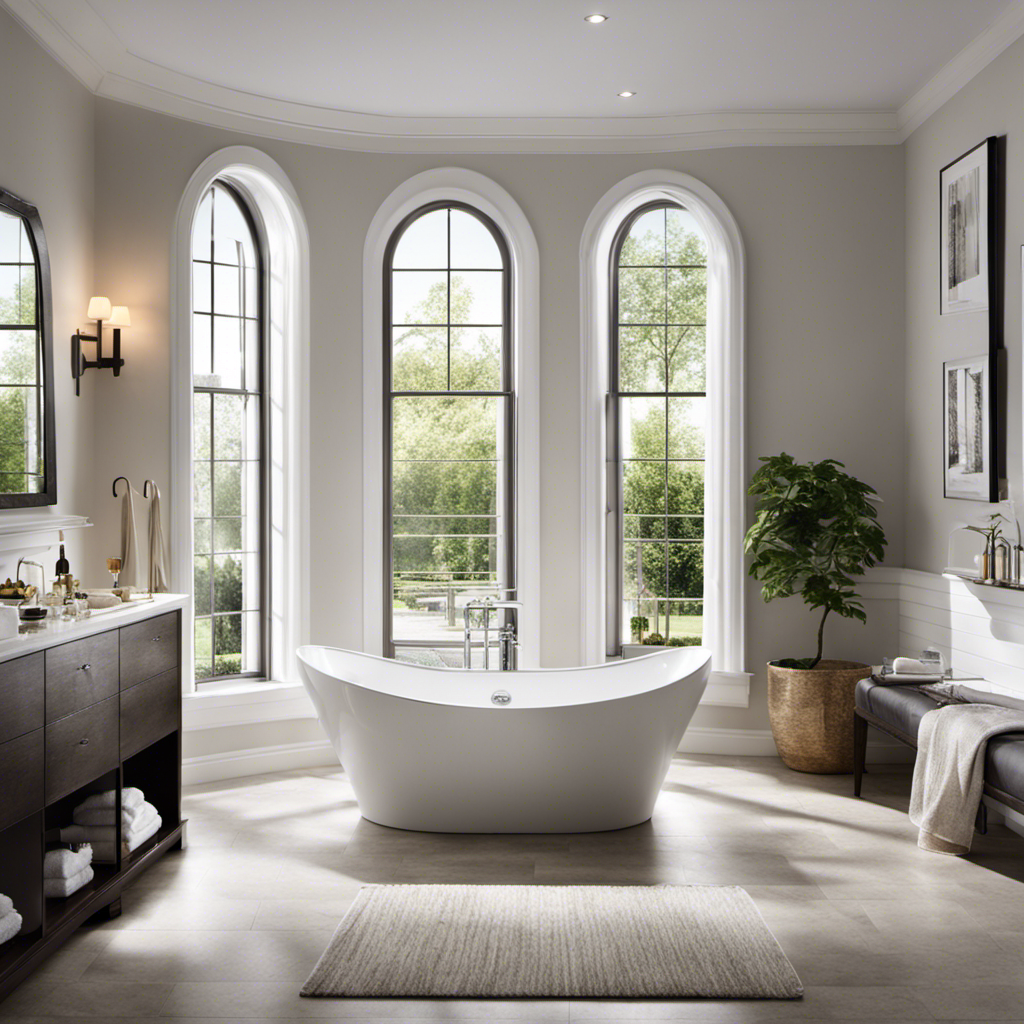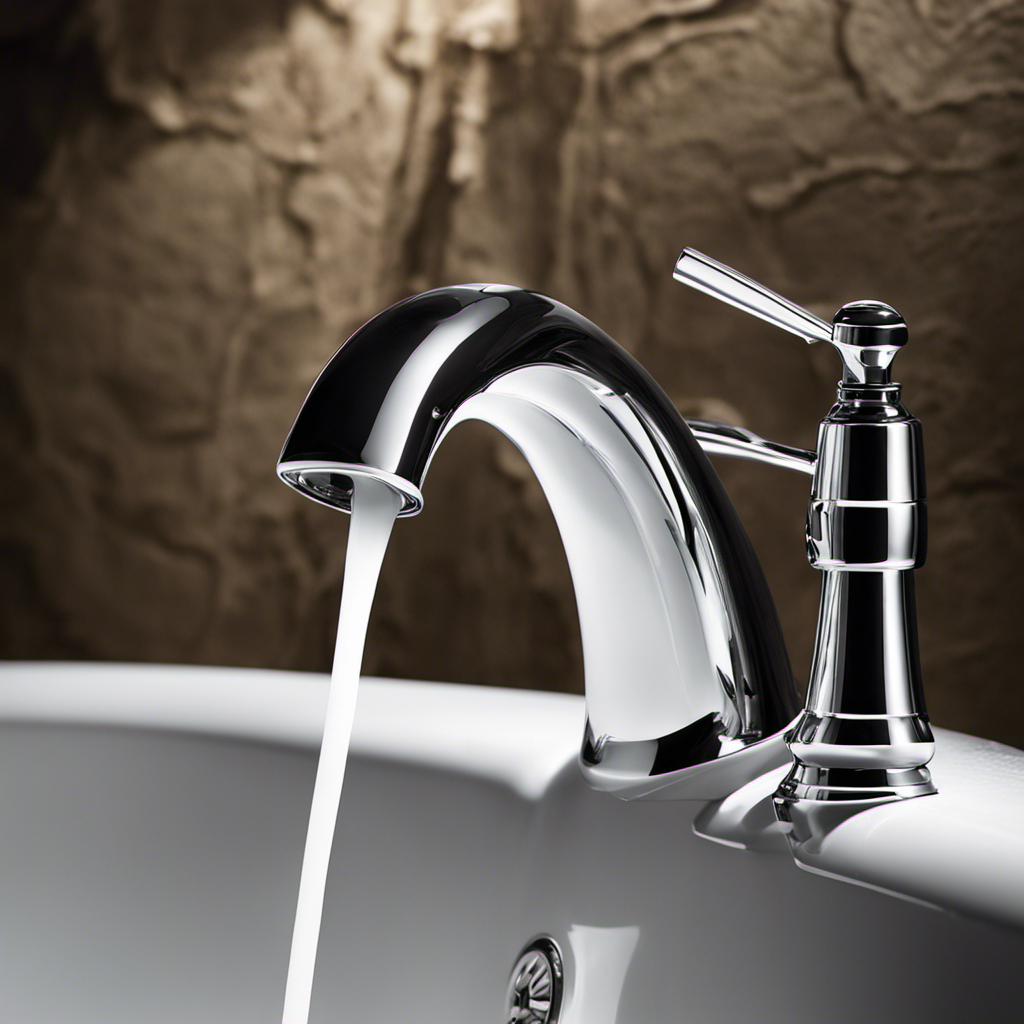Are you wondering about the size of a standard bathtub? Well, you’ve come to the right place!
In this article, we will delve into the dimensions, sizes, and measurements of standard bathtubs. We will explore the sizing standards and average dimensions to help you determine the size that best suits your needs.
Get ready to dive into the world of bathtubs and discover the perfect fit for your bathroom.
Key Takeaways
- Standard bathtubs vary between 60-72 inches in length
- Custom bathtub sizes are available to meet specific preferences and needs
- Small tubs are perfect for compact bathrooms or minimalist design
- Large tubs offer a luxurious bathing experience
Dimensions of a Standard Bathtub
The dimensions of a standard bathtub typically vary between 60-72 inches in length. This range is considered optimal for bathtub design as it allows for comfortable soaking and bathing experiences.
However, it is important to note that custom bathtub sizes are also available to meet specific preferences and needs. These custom sizes can cater to individuals who require larger or smaller tubs, ensuring that everyone can enjoy a relaxing bath.
When considering the size of a bathtub, it is essential to take into account the available space in your bathroom as well as any accessibility requirements.
Now that you understand the dimensions of a standard bathtub and the availability of custom sizes, let’s explore some common sizes of bathtubs to further guide you in making the right choice for your bathroom.
Common Sizes of Bathtubs
When it comes to choosing the right bathtub for your bathroom, it’s important to consider the optimal dimensions that will provide you with both comfort and functionality.
Small tubs are perfect for compact bathrooms or for those who prefer a more minimalist design.
On the other hand, large tubs offer a luxurious bathing experience and are ideal for those who enjoy soaking in a spacious tub.
Optimal Bathtub Dimensions
To find the optimal bathtub dimensions for your space, start by measuring the length and width of your bathroom. Consider any obstacles or restrictions that may affect the size of the bathtub.
Next, think about your personal preferences and needs. Do you prefer a deep soaking tub or a standard size? Consider how you will use the bathtub and how much room you want to have.
Also, take into account your physical abilities. If you have mobility issues or need assistance getting in and out of the tub, you may want to consider a smaller size or a bathtub with built-in grab bars.
Additionally, consider the style of your bathroom. Choose a bathtub size that complements the overall design.
Small Vs. Large Tubs
If you want a more spacious bathing experience, consider opting for a larger tub. While small tubs have their advantages, such as saving space and being more affordable, they may not provide the same level of comfort and relaxation as larger tubs. Large tubs offer several benefits that can enhance your bathing experience. Firstly, they provide more room to stretch out and move around, allowing for a more comfortable soak. Secondly, larger tubs often come equipped with additional features such as whirlpool jets or built-in seating, adding to the overall luxury and relaxation. However, it’s important to note that larger tubs also have some disadvantages. They require more space in your bathroom and may be more expensive to install. Additionally, larger tubs require more water to fill, which can lead to higher water bills.
| Small Tub Advantages | Large Tub Disadvantages |
|---|---|
| Space-saving | Requires more bathroom space |
| Affordable | More expensive to install |
| Requires more water to fill |
Typical Measurements for Bathtubs
Did you know that a standard bathtub typically measures around 60 inches in length? Bathtub design and materials play a crucial role in determining the size of a standard bathtub. Here are some interesting facts about bathtub measurements:
-
Length: As mentioned earlier, the average length of a standard bathtub is approximately 60 inches. This length allows for comfortable bathing and relaxation.
-
Width: Standard bathtubs usually have a width of about 30 to 32 inches. This width provides ample space for an average-sized person to comfortably sit or lie down in the tub.
-
Depth: The depth of a standard bathtub ranges from 14 to 20 inches. This depth ensures that there is enough water capacity for a relaxing soak.
-
Shape: Most standard bathtubs have a rectangular shape, but there are also oval and corner-shaped options available.
Knowing these measurements can help you choose the right bathtub for your needs. Now, let’s move on to explore different standard bathtub sizes.
Standard Bathtub Sizes
The average length of a standard bathtub is around 60 inches, while the width typically ranges from 30 to 32 inches.
When it comes to the optimal bathtub depth, it is recommended to have a depth of around 14 to 17 inches. This depth allows for a comfortable bathing experience while still ensuring that the water does not overflow.
When installing a standard bathtub, it is important to follow certain guidelines. The bathtub should be placed against a wall, with a minimum of 30 inches of clearance in front of it for easy access.
It is also essential to ensure that the plumbing and drainage systems are properly connected and functional.
Adhering to these standard bathtub installation guidelines will help ensure a safe and functional bathing space.
Sizing Standards for Bathtubs
If you’re in the market for a new bathtub, it’s important to be aware of common bathtub dimensions and industry bathtub size standards.
Knowing these key points will help you make an informed decision and ensure that your new bathtub fits perfectly in your bathroom.
From standard sizes to industry standards, understanding the dimensions will ensure a seamless and enjoyable bathing experience.
Common Bathtub Dimensions
Standard bathtubs typically have dimensions that range from 60 to 72 inches in length. These dimensions are considered standard because they fit comfortably in most bathrooms and provide enough space for an enjoyable bathing experience.
When it comes to optimal bathtub design, space-saving bathtubs are a popular choice. They are designed to maximize the use of available space while still providing a relaxing bathing experience. Here are four features of space-saving bathtubs that you might find appealing:
-
Compact size: Space-saving bathtubs are designed to be smaller in size, making them perfect for bathrooms with limited space.
-
Corner installation: These bathtubs can be installed in the corners of the bathroom, freeing up more floor space for other fixtures or storage.
-
Built-in storage: Some space-saving bathtubs come with built-in storage options, such as shelves or compartments, allowing you to keep your bath essentials within reach.
-
Multi-functional: Certain space-saving bathtubs are designed to serve multiple purposes, such as functioning as a shower as well.
Choosing a space-saving bathtub can help you optimize your bathroom layout while still enjoying the benefits of a relaxing bath.
Industry Bathtub Size Standards
When it comes to industry standards for bathtub dimensions, it’s important to consider the requirements of different bathroom layouts. Bathtub size regulations vary across regions, but there are some common standards that can help guide your decision.
The impact of bathtub size on bathroom design is significant. A larger bathtub can create a luxurious and spa-like atmosphere, but it may require more space and can limit other design options in your bathroom. On the other hand, a smaller bathtub can save space and allow for more flexibility in the overall bathroom layout.
It’s crucial to strike a balance between the size of the bathtub and the available space in your bathroom to ensure functionality and aesthetics.
Average Dimensions of Bathtubs
You’ll find that most bathtubs have average dimensions that can comfortably fit one person. However, there are various bathtub size trends and custom bathtub dimensions available in the market to cater to different needs and preferences. Here are some key points to help you understand the average dimensions of bathtubs:
-
Standard bathtubs typically measure around 60 inches in length, 30 inches in width, and 14-17 inches in depth.
-
Compact bathtubs, also known as small or corner bathtubs, are designed to fit into smaller bathrooms and usually measure around 48-60 inches in length, 32-36 inches in width, and 14-16 inches in depth.
-
Larger bathtubs, such as soaking tubs or freestanding tubs, can measure up to 72 inches in length, 36 inches in width, and 20 inches in depth.
-
Custom bathtub dimensions can vary greatly depending on individual preferences, with some opting for oversized or uniquely shaped bathtubs.
These size trends and custom options allow individuals to find the perfect bathtub that suits their specific requirements and enhances their bathing experience.
Determining the Size of a Standard Bathtub
Most bathtubs typically have dimensions that can comfortably fit one person, and it is important to determine the right size for your specific needs.
When measuring bathtub space, you should consider both the length and width of your bathroom. Measure the available area and make sure to account for any obstructions such as walls or fixtures.
Once you have the measurements, you can start choosing the right bathtub size. Standard bathtubs usually range from 60 to 72 inches in length and 30 to 32 inches in width. However, if you have a smaller bathroom, you may opt for a compact bathtub that is around 50 to 60 inches in length. On the other hand, if you have a larger space, you can go for a soaking tub that is 72 inches or longer.
Consider your personal preferences and the available space to find the perfect bathtub size for your bathroom.
Frequently Asked Questions
Can a Standard Bathtub Be Used for a Shower as Well?
You can use a standard bathtub for a shower, but there are pros and cons. The size of the tub may limit your movement, but it’s a cost-effective option. Alternatively, consider other shower options for small bathrooms.
What Are the Most Common Materials Used for Standard Bathtubs?
When it comes to standard bathtubs, the most common materials used are acrylic, fiberglass, and porcelain-enameled steel. Each has its pros and cons, and they offer a wide range of design and style options.
What Are the Dimensions of a Bathtub Suitable for a Small Bathroom?
If you have a small bathroom, you’ll want to consider a bathtub with dimensions that fit your space. It’s important to check bathtub regulations and choose a material that suits your needs.
Are There Any Regulations or Building Codes Regarding the Size of a Standard Bathtub?
There are regulations on bathtub size and minimum dimensions that need to be followed. It’s important to know the specific requirements for your area before installing a standard bathtub.
Can a Standard Bathtub Be Customized to Fit Specific Measurements or Requirements?
You’ll be pleased to know that standard bathtubs can indeed be customized to fit specific measurements or requirements. There are various customization options available, including space-saving designs, to ensure your bathtub meets your exact needs.
Conclusion
So now you know the size of a standard bathtub. Hopefully, this information has helped you in your search for the perfect bathtub for your bathroom.
But did you know that the average dimensions of a bathtub have actually increased over the years? In the 1960s, the average bathtub size was around 5 feet long and 14 inches deep. Today, the standard size is closer to 6 feet long and 18 inches deep.
This statistic highlights the evolving trends in bathroom design and the growing importance of comfort and relaxation in our lives.










